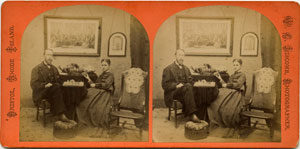As I eagerly sorted through what seemed to be an inexhaustible supply of boxes of stereographs at the American Antiquarian Society (AAS), I came to a stop at the view of Broadway on a Rainy Day from about 1859. Stereographs were an early form of three-dimensional photography that used a pair of two-dimensional images, side by side, to be viewed in a special stereo viewer (fig. 1). The rectangular orange card with its dual images featured a long perspective along glistening streets and crowded sidewalks, filled with umbrella-covered pedestrians and horse-drawn vehicles, all caught in mid-motion, except for a small carriage in the immediate foreground. This view of Broadway and New York itself was a very different image of the city than its photographic predecessors that had either offered blurred figures or streets devoid of activity, in order to make up for their long exposures. With little text on the front other than copyright, I turned over the card and read: Anthony’s Instantaneous Views, Broadway on a Rainy Day, no. 5095, Published by E. & H. T. Anthony & Co., American and Foreign Stereoscopic Emporium, 501 Broadway New York (fig. 2).
I was starting a new project, “New York as Cultural Capital,” a study of how New York City and several of its key manufacturing trades were critical to the cultural development of a new Victorian domestic culture, materialized in parlor suites of furniture, displays of stereographs and chromolithographs, and plaster figures. Middle-class Americans eagerly sought these household objects that signified culture and refinement by their associations with artistic taste and worldly knowledge. First, I decided to tackle AAS’s stereograph collection, more specifically, the stereos of E. & H. T. Anthony & Co., one of the largest American producers. The firm was located on several sites on Broadway, from which they sent forth thousands of images of domestic and foreign scenes. Cultural production and direction increasingly came from urban places in the nineteenth century, and New York was at the center of that reorientation of American culture. That new metropolitan culture became the national culture through the efforts of an important group of cultural entrepreneurs that included Edward Anthony, Currier & Ives, John Rogers, and the Harper Brothers—the subjects of my project.
The AAS has 50,000 to 60,000 stereograph cards, well over 300 boxes, mostly views of American landscapes and city views; they are organized by place rather than producer. I had decided to start with the New York City views. While leafing through the boxes with many interesting views of Central Park or Astor Place, I had come upon this one that seemed familiar, iconic as it turned out, given that it had been included in the Metropolitan Museum of Art’s online Timeline of Art History’s sampling of nineteenth-century photography. It appeared in Anthony’s very first set of city views, although this one was renumbered 5095 in a later series. Indeed, Anthony’s early stereographic catalogues and his advertisements featured testimonials of this view and similar views of Broadway: Broadway was a familiar scene for Anthony and others, the bustling commercial venue of the nation’s growing metropolis. There seemed to be a story centered on this fascinating image.
Anthony’s Broadway on a Rainy Day became a significant statement for the firm and for the stereoscope itself, partly because Broadway symbolized a thriving, bustling commercial metropolis.
Like many other photographic entrepreneurs during the exciting years after the introduction of the daguerreotype, Edward Anthony made his start by making and selling the unique (they could not be reproduced) silvered and shimmering images on a plate, invented by Louis-Jacques-Mandé Daguerre in 1839. But Anthony’s great success came less by selling photographs in the fashion of Mathew Brady, whose products and production studio made him known as Brady of Broadway, but rather by his mastery of the photographic supply business on that very same street. Anthony was born in New York City in 1818 and after graduating from Columbia College in civil engineering, worked on the Croton Aqueduct, the engineering marvel that supplied the city with water and facilitated its enormous growth into the Empire City—along with the Erie Canal. He took lessons with the painter and inventor Samuel Morse, who had been in Paris when Daguerre made his first demonstrations, and was one of the first Americans to experiment with what he called “one of the most beautiful discoveries of the age.” One of his former Columbia professors, James Renwick, asked for his assistance in photographing some of the land in the northeastern boundary dispute between Great Britain and the United States. Anthony took along his new apparatus, and his plates proved invaluable in the eventual settlement that was known as the Webster-Ashburton Treaty of 1842. Soon after, Anthony made photography his profession and opened a studio in Washington to secure portraits of all the members of Congress along with other notables for a venture called the National Daguerreian Miniature Gallery. Anthony, like many of his peers, easily moved between the work of artist and artisan, inventor and entrepreneur at a time when professions and fields of expertise remained in flux.
After the great influx of aspirants into the trade, the daguerreotype profession consolidated in the later part of the 1840s. Many former artisans or artists went back to their previous professions, while others secured fame and fortune for their artistic representations and advertising prowess, including Brady as well as Southworth and Hawes of Boston. Anthony looked in a different direction: he sold his interest in the daguerreotype gallery and started selling photographic supplies and engravings in 1847, at 205 Broadway, the same building as Brady’s studio. Soon he was manufacturing materials as well, and formed a partnership with his older brother Henry that became the leading photographic supply house in the United States in the second half of the nineteenth century. Every photographer needed these supplies, and business expanded rapidly. Jobbers, the precursors of wholesalers, arose in a host of different industries as the marketing system in the United States matured. Anthony built his supply depot at 308 Broadway, followed by a succession of ever-more elaborate Broadway buildings as the business moved continually uptown to more stylish quarters, like the rest of Manhattan’s businesses and residents.
Stereographs had first been popularized in Europe, with the stereo daguerreotype being the first photographic process to take advantage of the binocular effect that offered a three-dimensional vision when held in a special viewer. Scientific interest in the process soon gave way to great enthusiasm for its possibilities as a consumer product. The Langenheim Brothers of Philadelphia pioneered commercial stereographic views that were made from negatives and then printed on glass. This negative process allowed for multiple reproductions and solved the problem posed by the daguerreotype’s unique image. These early efforts were soon succeeded by the advent of the collodion or wet plate process, where a piece of glass was coated with a layer of iodized collodion, dipped in a light-sensitive silver solution in a darkroom, and then used to make an exposure before the chemicals dried. The Langheims didn’t just work on the technical side, they also recognized the need to produce popular images that consumers wanted. They secured local financial backers to embark upon a project called “American Views,” the beginning of the stereograph’s primary use as a landscape medium, creating countless stereoscopic series that brought images of domestic and international landscapes into the middle-class parlor for family viewing. From the series “New York & Vicinity” comes their “View from Peter Cooper’s Institute Towards Astor Place,” from around 1856, a stereograph glass positive in the New York Public Library. However, their experiments with albumenized paper stereographs, using paper coated with egg white and salt and then sensitized for printing a negative in sunlight, produced much cheaper and more popular commodities.
Other photographic entrepreneurs recognized the potential of stereographs as popular entertainment. The Boston team of Southworth & Hawes designed the grand parlor or gallery stereoscope (fig. 3) “a complete Picture Gallery in itself” with its three-dimensional views—”A view of the street seems the street itself”—that could be seen in their Tremont Street studios in 1853. But this expensive apparatus was not designed for ordinary homes. By 1858, when Edward Anthony first entered into the stereo “craze” with a box of a dozen views of the Fulton Street Prayer meetings, other Broadway merchants such as the publishers D. Appleton Company had already recognized the potential market as shown in the view of their Stereoscopic Emporium with its crowded shelves and displays of Stereoscopic Views everywhere. An article in the American Journal of Photography that same year highlighted some of the major attractions of the boom, reporting “stereoscopes are at last coming into vogue with us … this maybe somewhat owing to price since they can be bought for $1.50 a dozen.” They went on to say that it would be strange “if many parlors were without them,” for what would better suit a guest waiting for the lady of the house to appear, or “What better interlude during an evening party than to fill up a pause with a glance at a fine stereoscopic view?”
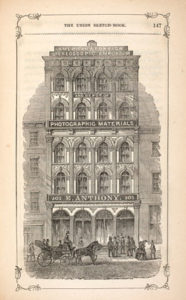
Edward Anthony’s success as a stereographic entrepreneur was built upon a series of innovative commercial and technical practices. He started by importing European stereographs but soon built his business around the popularity of domestic views, and his fortunate location in New York City contributed to his success. Anthony manufactured albumen photographic paper for prints from imported German paper of the highest quality. He improved the sensitivity of the collodion negative emulsion and the shutter technology of the camera so that his views were about 1/40 of a second compared to most others of 30 seconds or longer. His cameras were small, simple and lightweight affairs with tiny negatives. Fortuitously for the stereo’s popularization, expensive and cumbersome stand-alone viewers, pieces of household furniture, were replaced or at least supplemented by the light and simple Holmes-Bates stereoscope, invented by Oliver Wendell Holmes Sr. in 1859 and refined by Boston merchant Joseph Bates (fig. 4). The physician and author wrote several influential essays in the Atlantic that contributed mightily to the popularization of the stereograph. His stereo viewer with its small board, two lenses, and a projecting arm to place the stereograph, which could be held up to the user’s eyes, became the viewer of choice for the remainder of the nineteenth century. Also, Anthony ventured into mass production, employing over fifty women and also male workers in the process—some selected the prints while others trimmed, mounted, and finished the pictures. The views were printed on albumen paper using the glass collodion negatives in a separate building with plenty of light. An albumen paper factory of women workers opened at 65 Broadway to meet the mounting demand. Although little was mechanized, the processing used an assembly line system that allowed the Anthony employees to produce two to three thousand cards a day, or over a million a year! “Each single process in the manufacture of elaborate products of skill oftentimes seems, and is, very simple,” Holmes noted in an 1860 Atlantic essay, after a visit to the Anthony establishment.
Anthony’s final innovation was not his alone or even purely associated with the stereoscope—the parlorization of the commodity that made the stereograph one of the essential parts of the domestic scene. This process was well under way by the time of the 1858 American Journal of Photography article, but was certainly advanced by Anthony when he opened his own stereoscopic emporium in May of 1860 at 501 Broadway, one of the grand commercial palaces that lined mid-century Broadway (figs. 5-7). Anthony’s Frank Leslies ad of 1859 had already recommended that “No visitor should leave New York without some of them [Anthony stereos] to astonish friends at home.” But the opening of the “American & Foreign Stereoscopic Emporium and Depot of Photographic Materials,” as the prominent lettering on the building’s façade boasted, was marked by an extensive advertising campaign and the issuing of their first catalog of stereoviews. The establishment offered a selection of parlor items as well: photography albums, cabinet and card pictures and chromos alongside stereoscopic views. When the English writer and photographer John Werge visited New York in April of 1860, he remarked: “What a wonderful place New York is for photographic galleries.” Werge exclaimed how everything in the metropolis was mammoth, such as the “saloons,” the stores, and the galleries.
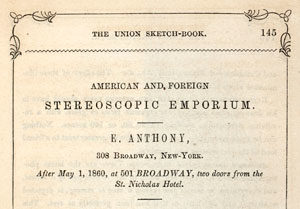
And the most mammoth, of all is the ‘store’ of Messrs. E. & H.T. Anthony, on Broadway. This establishment is one of the many palaces of commerce on that splendid thoroughfare. The building is of iron, tall and graceful, of the Corinthian order, with Corinthian pilasters, pillars, and capitals. It is five storeys high, with a frontage of about thirty feet, and a depth of two hundred feet, running right through the ‘block’ from Broadway to the next street on the west side of it. This is the largest store of the kind in New York.
Werge went on to say that the city was renowned on two continents for its vast stock of photographic supplies, and its two proprietors for their commercial and technical enterprise.
Anthony’s Broadway on a Rainy Day became a significant statement for the firm and for the stereoscope itself, partly because the Anthony business was located on the great avenue as a pioneer “palace of commerce,” but also because Broadway symbolized for Americans and those abroad alike the image of a thriving bustling commercial metropolis. In addition, the “instantaneous” stereograph represented itself (or at least Anthony made that claim) as an article of modernity. Urban views became a staple of the stereo catalog, replacing the daguerreotype’s portraits. By concentrating “on the encyclopedic, ‘objective’ documentary potential of the stereoscope and its view,” American Studies scholar Laura Schiavo has argued, “the vogue in stereoscopic views turned to landscapes, city views, and other subjects far more suited to the delineation of national, political, and cultural identity.” Daguerreotypists had early on tried out their cameras on the still streets before their windows as Anthony himself recalled: “I amused myself by taking pictures out of the back windows.” But in 1860 Holmes invoked the difference in discussing this very view of Broadway: “It is the Oriental story of the petrified city made real to our eyes … But what a wonder it is, this snatch at the central life of a mighty city as it rushed by in all its multitudinous complexity of movement!” Still, if we observe a series of Anthony’s Broadway views (fig. 9), we can start to see the formulaic qualities that marked all of his city views, as photographic historian Peter Hales has noted. When Anthony held his camera out a second floor balcony, the goal was to obtain the greatest dimension of depth down the street by minimizing foreground areas that might have blurred motion. The shutter was released when the maximum amount of activity would be registered with its arrested movement, as had caught Holmes and others’ imagination, and he framed the arrested movement with a triangular wedge of sky balanced against the triangular angle of the street.
New York was the subject of many Anthony stereographs and was also the center of Anthony’s national system of production and distribution. The firm contracted with a network of brokers to secure photographs for their inventory of American Scenes and distributed their views over the new rail system across the continent. Broadway on a Rainy Day was part of a series of 175 instantaneous views that included other views of the New York Harbor and other street scenes such as the series on the visit of the Japanese Embassy to New York in June of 1860 (http://digitalgallery.nypl.org/nypldigital/id?G91F182_030F). By 1873, their trade list included over 11,000 items. Hales insightfully argues that Anthony’s stereographs take an innovative approach to the representation of the city as process, while also utilizing conservative characteristics in their visual depiction and business practices to maximize their adoption in the American home.
After looking at my boxes of Anthony and other stereographs at AAS along with advertisements and periodical articles, I could better understand how these objects became part of a common imagery that took its place in the home, where they could also serve as a focus in the parlor for visiting and other social activities. Shared visual libraries or the creation of a family museum was the goal for stereographs, some commentators claimed. The city in these views was represented as a culture-cohering force, a universal democratic world of art and amusement. As an 1860 advertisement for the American and Foreign Stereoscopic Emporium that appeared in many newspapers put it: The stereoscope was the “most Instructive, interesting, entertaining, amusing and exciting of modern inventions.” No home would be complete without it, “and it must and will penetrate everywhere,” and, to extend the theme of cultural advancement, to “EVERY GENTLEMEN OF WEALTH AND REFINEMENT.” The means of creating a proper parlor became available to all those willing and able to purchase the necessary mass consumer goods. See, for example, the Lipscomb Stereo (fig. 10) of a couple playing chess in their parlor with their prints, doilies draped over the rocking chair, and the woman holding a book in one hand, with the stereo viewer on the table behind, all attesting to their mastery of the tools of refined living. Objects were culture in tangible form, historian Katherine Grier writes, and the parlor, with its formulaic vocabulary of furniture, carpets, decorative lighting objects, center tables, pianos, and stereoviews, was the “theater of culture” in the Victorian age. Anthony’s Broadway on a Rainy Day, as I had come to realize, was no mere illustration but helped to create that new culture.
Further reading:
For stereographs, see Edward Earle, ed., Point of View: The Stereograph in America: A Cultural History (Rochester, N.Y., 1979), and Laura Schiavo, “A Collection of Endless Extent and Beauty: Stereographs, Vision, Taste and the American Middle Class, 1850-1880” (PhD diss., George Washington University, 2002). Other works include Robert Silverman, “The Stereoscope and Photographic Depiction in the 19th Century,” Technology and Culture 34 (October 1993): 729-756; Laura Schiavo, “From Phantom Image to Perfect Vision: Physiological Optics, Commercial Photography, and the Popularization of the Stereoscope,”New Media, 1740-1915, eds. Lisa Gitelman and Geoffrey B. Pingree (Cambridge, Mass., 2003), 113-137. For thinking about the parlor and domestic scene, see Shirley Wajda, “A Room with a Viewer: The Parlor Stereoscope, Comic Stereographs, and the Psychic Role of Play in Victorian America,” Hard at Play: Leisure in America, 1840-1900 (Rochester, N.Y., 1992), 112-38.
William C. Darrah has written several pioneering works including Stereo Views: A History of Stereographs in America and their Collection (Gettsyburg, Pa., 1964) and World of Stereographs (Gettysburg, Pa., 1977). Peter Hales’ Silver Cities: Photographing American Urbanization, 1839-1939 (rev. ed., Albuquerque, N.M., 2005), focuses on urban photography and discusses the importance of Anthony’s Broadway series. Peter Wing, Stereoscopes: The First Hundred Years (Nashua, N.H., 1996) is the standard guide to stereoviewers.
On Anthony, William Marder has written a comprehensive monograph Anthony: The man, the company, the cameras (Plantation, Fla., 1982). Reese Jenkins discusses Anthony’s manufacturing and marketing practices in Images and Enterprise: Technology and the American Photographic Industry, 1839-1925 (Baltimore, 1975). John Werge’s visit to Anthony and other New York photographic establishments is found in his Evolution of Photography (London, 1890). Anthony published several catalogs starting with their daguerreotypes and then their stereoviews. The AAS has a comprehensive run of Anthony’s Photographic Bulletin (1870-1902). Oliver Wendell Holmes published several important articles on stereographs starting with “The Stereoscope and the Stereograph” in the Atlantic in June of 1859.
Finally, there are the stereographs. The AAS has a marvelous collection organized by state and the remainder by topic athttp://www.americanantiquarian.org/stereographs.htm Other significant collections include the New York Public Library: see the NYPL Digital Gallery’s Robert Dennis Collection of Stereoscopic Views, with over 72,000 stereographs, at http://digitalgallery.nypl.org/nypldigital/explore/dgexplore.cfm?col_id=361
The George Eastman House has over 500 Anthony stereographs online at http://www.geh.org/fm/st05/htmlsrc/anthony_idx00001.html And then there’s lots on eBay.
This article originally appeared in issue 10.4 (July, 2010).
David Jaffee passed away in 2017. He previously taught American Material Culture and was Head of New Media Research at the Bard Graduate Center. He wrote extensively about early American artisans and art. His book A New Nation of Goods: Material Culture in Early America was published in 2010 by the University of Pennsylvania Press.





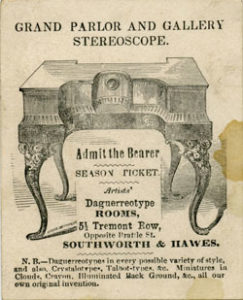

![Fig. 6. "Broadway on a Rainy Day [looking north]," E. & H. T. Anthony, Anthony's Instantaneous Views No. 188 (1859), author's collection.](https://commonplace.online/wp-content/uploads/2016/06/10.4.Jaffee.6-300x143.jpg)
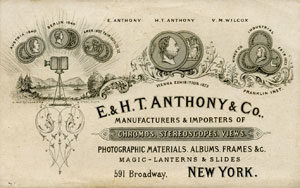
![Fig. 9. "Broadway on a Rainy Day [looking north]," E. & H. T. Anthony, Anthony's Instantaneous Views No. 188 (1859), author's collection.](https://commonplace.online/wp-content/uploads/2016/06/10.4.Jaffee.9-300x143.jpg)
